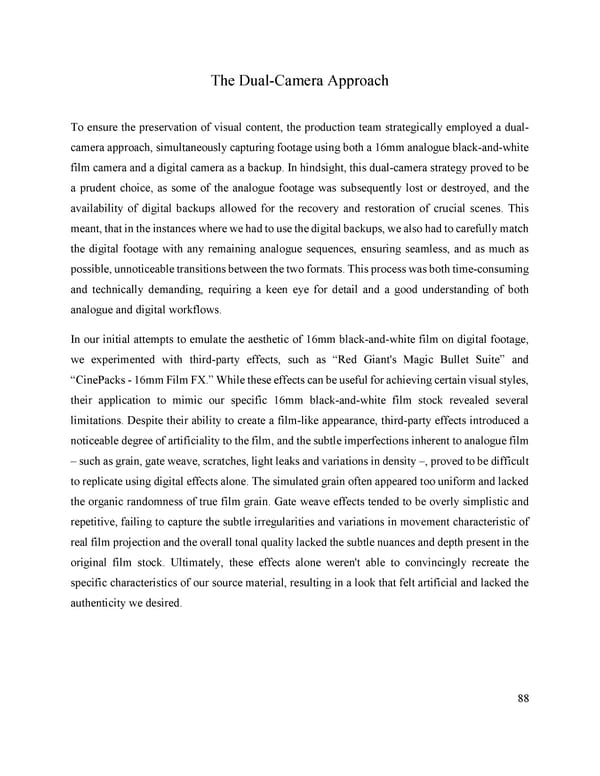The Dual-Camera Approach To ensure the preservation of visual content, the production team strategically employed a dual- camera approach, simultaneously capturing footage using both a 16mm analogue black-and-white film camera and a digital camera as a backup. In hindsight, this dual-camera strategy proved to be a prudent choice, as some of the analogue footage was subsequently lost or destroyed, and the availability of digital backups allowed for the recovery and restoration of crucial scenes. This meant, that in the instances where we had to use the digital backups, we also had to carefully match the digital footage with any remaining analogue sequences, ensuring seamless, and as much as possible, unnoticeable transitions between the two formats. This process was both time-consuming and technically demanding, requiring a keen eye for detail and a good understanding of both analogue and digital workflows. In our initial attempts to emulate the aesthetic of 16mm black-and-white film on digital footage, we experimented with third-party effects, such as “Red Giant's Magic Bullet Suite” and “CinePacks - 16mm Film FX.” While these effects can be useful for achieving certain visual styles, their application to mimic our specific 16mm black-and-white film stock revealed several limitations. Despite their ability to create a film-like appearance, third-party effects introduced a noticeable degree of artificiality to the film, and the subtle imperfections inherent to analogue film – such as grain, gate weave, scratches, light leaks and variations in density –, proved to be difficult to replicate using digital effects alone. The simulated grain often appeared too uniform and lacked the organic randomness of true film grain. Gate weave effects tended to be overly simplistic and repetitive, failing to capture the subtle irregularities and variations in movement characteristic of real film projection and the overall tonal quality lacked the subtle nuances and depth present in the original film stock. Ultimately, these effects alone weren't able to convincingly recreate the specific characteristics of our source material, resulting in a look that felt artificial and lacked the authenticity we desired. 88
 Lost Analogue: Exploring Film, Music, and Interdisciplinary Methods in Education Page 88 Page 90
Lost Analogue: Exploring Film, Music, and Interdisciplinary Methods in Education Page 88 Page 90